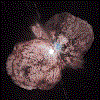
Eta Carinae
May be one of the more massive stars in our Galaxy: 100 times the Sun. It radiates about five million times more power than our star.
Even though it's more than 8000 light-years away, structures about the diameter of our solar system can be distinguished in this picture.
Because Eta Carinae is so far away, we see it now with the aspect it had more than 8000 years ago: when only 150 years had spanned since the start of this giant outburst.
The cataclism produced two polar lobes and a thin equatorial disc, all moving outward at about 1.5 million miles per hour (2.5 millions km/h).
Clicking on the image on the left you will get the JPG version (37 Kbytes. You can access higher resolution images as well: 118K (GIF) and 250K (300 dpi JPG).
A 3-D image is also availabe. The picture was assembled from two images of Eta Carinae taken 17 months apart (April 1994, September 1995). The motion of the gas and dust between the observations, and Hubble's high resolution, allows astronomers to combine and encode the images to reveal the true three-dimensional geometry of the system.